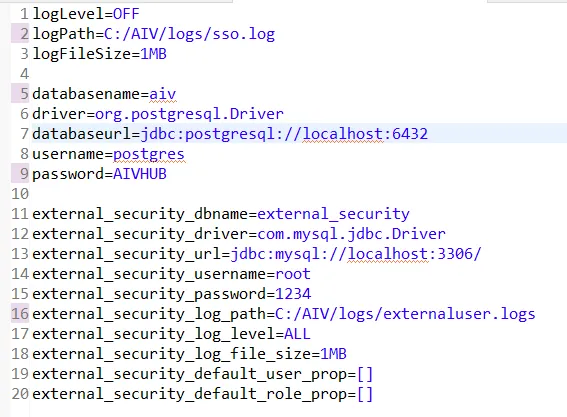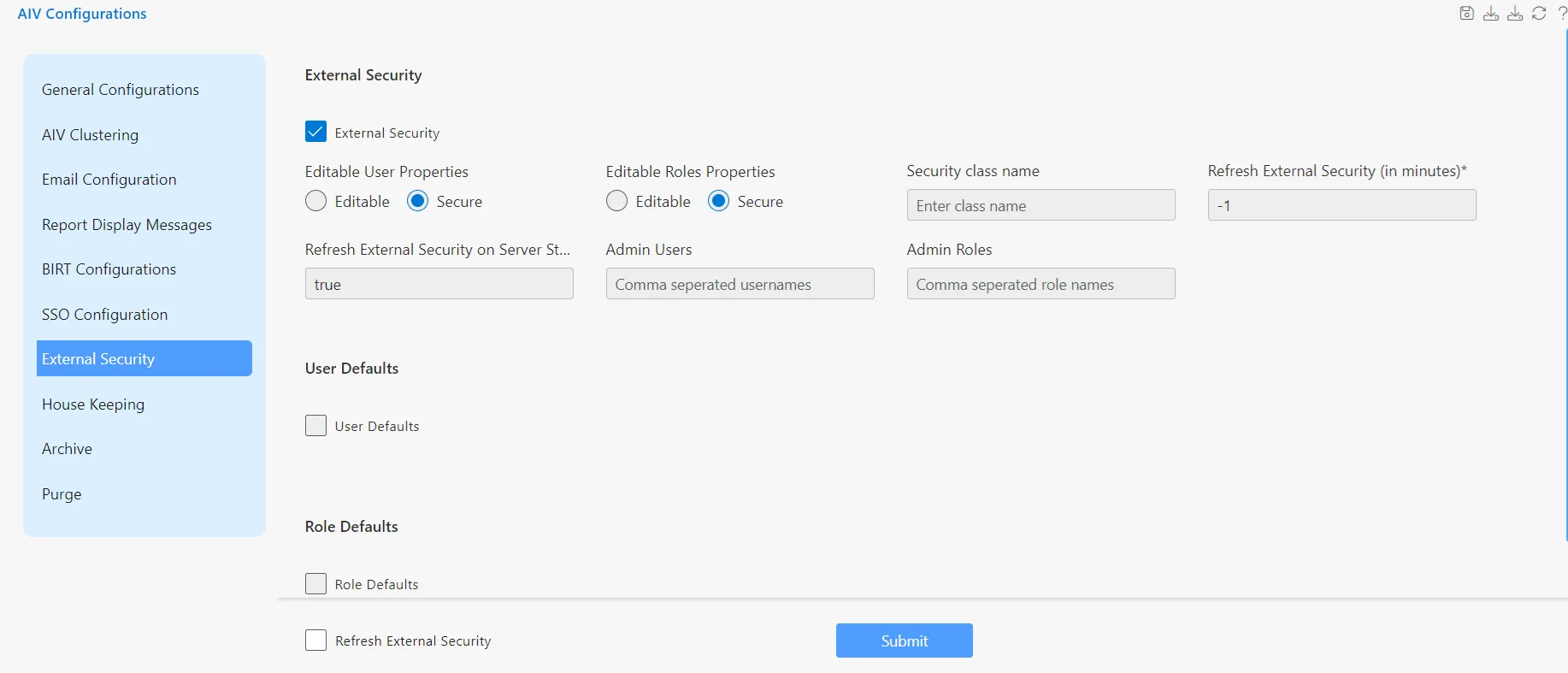External Security Code Explanation
Introduction
-
This document contains explanations of External Security code developed by AIV. In this document, we have explained each method of External Security to help users understand its functionality.
-
This method of external security is utilized when user data resides on a database server. In addition to the resources you have downloaded from the SSO & External security document, you will find an
externalsecurity_db.propertiesfile in thefilesfolder of theAIV External Securityproject. All the database connection information is derived from this properties file.
Following are the changes to be made to connect with your database:
- logPath: Change the log file path here and provide your directory path.
- databasename: Provide database name of your aiv application.
- driver: Provide driver class name here.
- databaseurl: Provide database connection URL of aiv.
- username & password: User name & password of aiv database.
-
external_security_dbname: Provide name of database where your user list is lying.
-
external_security_driver: Provide the driver class name for users list database.
-
external_security_url: Provide database connection URL to connect with database where user list is available.
-
external_security_username: User name to connect with external database.
-
external_security_password: Password to connect with external database.
-
external_security_log_path: Provide path for log file.
Once the mentioned properties updated in externalsecurity_db.properties file, save the changes and proceed to check the steps below for any modifications.
- The code starts with importing required dependencies as shown in below code snippet.
package com.aiv.externalsecurity;
import java.io.FileInputStream;
import java.io.IOException;
import java.io.InputStream;
import java.sql.Connection;
import java.sql.DriverManager;
import java.sql.PreparedStatement;
import java.sql.ResultSet;
import java.sql.SQLException;
import java.util.ArrayList;
import java.util.HashMap;
import java.util.Iterator;
import java.util.List;
import java.util.Map;
import java.util.Properties;
import java.util.logging.FileHandler;
import java.util.logging.Handler;
import java.util.logging.Level;
import java.util.logging.Logger;
import java.util.logging.SimpleFormatter;
import com.activeintelligence.external.auth.ExternalSchema;
- Below code is to initialization of java logger. In Java, logging is an important feature that helps developers to trace out the errors. Java is the programming language that comes with the logging approach. It provides a logging API that was introduced in Java version 1.4 . It provides the ability to capture the log file.
- Here we have initialized logger and provided path where this log file will be stored.
public class ExternalSecurityDBImpl implements ExternalSchema { //initialization of logger
private static final Logger logger = Logger.getLogger(ExternalSecurityDBImpl.class.getName());
private static final String BASE_PATH="C:/Users/aivhu/Downloads/aiv External Security & SSO/aiv External Security/files/";
private static final String LOG_FOLDER="C:/aiv/logs/";
private Properties properties = null;
private Connection connection = null;
}- Below code is used to get external settings if any like database properties, logs or database table names etc.
public ExternalSecurityDBImpl() { ////to read external settings if any
try {
properties = new Properties();
InputStream input = new FileInputStream(BASE_PATH+"externalsecurity_db.properties");
properties.load(input);
Handler fileHandler = new FileHandler(LOG_FOLDER+"external_security.log",true);
fileHandler.setLevel(Level.ALL);
fileHandler.setFormatter(new SimpleFormatter());
logger.setUseParentHandlers(false);
logger.addHandler(fileHandler);
} catch (IOException e) {
logger.severe(e.getMessage());
e.printStackTrace();
}
}- Below code is to establish connection with database. Database properties required to connect with the database are fetched from external property file defined in the above step.
private void getConnection() { //to open Database connection
if (connection == null) {
logger.info("Opening connection");
System.out.println("Opening connection");
try {
Class.forName(properties.getProperty("external_security_driver"));
String url = properties.getProperty("external_security_url")
+ properties.getProperty("external_security_dbname")+"?"+"useSSL=false";
System.out.println(url);
connection = DriverManager.getConnection(url, properties.getProperty("external_security_username"),
properties.getProperty("external_security_password"));
System.out.println(connection);
} catch (Exception e) {
logger.severe(e.getMessage());
}
}
}- This method is used to fetch all users from client database which is defined in property file.
public List<Map<String, Object>> getAllUsers() { //another way to fetch desired column data from database essential for aiv
getConnection();
List<Map<String, Object>> list = new ArrayList<Map<String, Object>>();
PreparedStatement mosl;
try {
String sqlScript = "SELECT firstName as \"firstName\", lastName as \"lastName\",userName as \"userName\", status, password, email,homeFolder as \"homeFolder\", backupUserId as \"backupUserId\",managerUserId as \"managerUserId\",dashboardOption as \"dashboardOption\",alertsOption as \"alertsOption\",reportOption as \"reportOption\",mergeReportOption as \"mergeReportOption\",resourceOption as \"resourceOption\",quickRunOption as \"quickRunOption\",mappingOption as \"mappingOption\",messageOption as \"messageOption\",datasetOption as \"datasetOption\",parameterOption as \"parameterOption\",annotationOption as \"annotationOption\",notificationOption as \"notificationOption\",requestOption as \"requestOption\",adminOption as \"adminOption\",scheduleOption as \"scheduleOption\",userType as \"userType\", default_dashboard, landing_page, locale, timezone,theme, notification, department FROM external_security.users";
mosl = connection.prepareStatement(sqlScript);
ResultSet rs = mosl.executeQuery();
while (rs.next()) {
Map<String, Object> row = new HashMap<String, Object>();
row.put("firstName", rs.getString("firstName"));
row.put("lastName", rs.getString("lastName"));
row.put("userName", rs.getString("userName"));
row.put("status", rs.getString("status"));
row.put("password", rs.getString("password"));
row.put("email", rs.getString("email"));
row.put("homeFolder", rs.getString("homeFolder"));
row.put("backupUserId", 1);
row.put("managerUserId", 1);
row.put("dashboardOption", "0");
row.put("alertsOption", "0");
row.put("olapAnalyticsOption", "0");
row.put("reportOption", "0");
row.put("mergeReportOption", "0");
// row.put("flyReportOption", "0");
row.put("resourceOption", "0");
row.put("quickRunOption", 0);
row.put("mappingOption", "0");
row.put("messageOption", "0");
row.put("datasetOption", "0");
// row.put("listOfValuesOption", "0");
row.put("parameterOption", "0");
row.put("annotationOption", "0");
row.put("notificationOption", "0");
row.put("requestOption", "0");
// row.put("recurringOption", "0");
row.put("adminOption", "0");
row.put("scheduleOption", "0");
row.put("userType", "INT");
row.put("default_Dashboard", null);
row.put("landing_Page", "");
row.put("locale", "en");
row.put("timezone", "SYSTEM");
row.put("notification", "0");
row.put("theme", "Default");
row.put("department", "Default");
list.add(row);
}
} catch (SQLException e) {
logger.severe(e.getMessage());
}
// list.stream().forEach(s->System.out.println(s));
return list;
}-
In above method, we fetch all columns from the table, in this method we fetch just required field of data from user table. Both methods work the same way; they retrieve users data from client database and store in to aiv database.
-
GetAllRoles method fetch all roles available in the client database. Which will be used to assign hierarchical access to a particular user.
@Override
public List<Map<String, Object>> getAllRoles() { //to fetch user roles from client database
getConnection();
List<Map<String, Object>> list = new ArrayList<Map<String, Object>>();
PreparedStatement moslrole;
String sqlScript = "SELECT name, description, email,dashboardOption as \"dashboardOption\",alertsOption as \"alertsOption\",reportOption as \"reportOption\",mergeReportOption as \"mergeReportOption\",adhocOption as \"adhocOption\",resourceOption as \"resourceOption\", quickRunOption as \"quickRunOption\",mappingOption as \"mappingOption\",messageOption as \"messageOption\",datasetOption as \"datasetOption\",parameterOption as \"parameterOption\",annotationOption as \"annotationOption\", notificationOption as \"notificationOption\",requestOption as \"requestOption\",adminOption as \"adminOption\",scheduleOption as \"scheduleOption\", department FROM external_security.roles";
try {
moslrole = connection.prepareStatement(sqlScript);
ResultSet rsa = moslrole.executeQuery();
while (rsa.next()) {
Map<String, Object> row = new HashMap<String, Object>();
row.put("name", rsa.getString("name"));
row.put("description", rsa.getString("description"));
row.put("email", rsa.getString("email"));
row.put("dashboardOption", rsa.getString("dashboardOption"));
row.put("alertsOption", rsa.getString("alertsOption"));
// row.put("olapAnalyticsOption", rsa.getString("olapAnalyticsOption"));
row.put("reportOption", rsa.getString("reportOption"));
row.put("mergeReportOption", rsa.getString("mergeReportOption"));
row.put("adhocOption", rsa.getString("adhocOption"));
// row.put("flyReportOption", rsa.getString("flyReportOption"));
row.put("resourceOption", rsa.getString("resourceOption"));
row.put("quickRunOption", rsa.getString("quickRunOption"));
row.put("mappingOption", rsa.getString("mappingOption"));
row.put("messageOption", rsa.getString("messageOption"));
row.put("datasetOption", rsa.getString("datasetOption"));
// row.put("listOfValuesOption", rsa.getString("listOfValuesOption"));
row.put("parameterOption", rsa.getString("parameterOption"));
row.put("annotationOption", rsa.getString("annotationOption"));
row.put("notificationOption", rsa.getString("notificationOption"));
row.put("requestOption", rsa.getString("requestOption"));
// row.put("recurringOption", rsa.getString("recurringOption"));
row.put("adminOption", rsa.getString("adminOption"));
row.put("scheduleOption", rsa.getString("scheduleOption"));
row.put("department", "Default");
list.add(row);
}
rsa.close();
moslrole.close();
} catch (SQLException e) {
logger.severe(e.getMessage());
}
return list;
}- This method find the users associated with specific role for each role.
@Override
public String[] selectUsersOfRole(String role, String department) { //used to fetch users corresponds to roles
getConnection();
PreparedStatement aisStats;
try {
aisStats = connection.prepareStatement("SELECT \"userName\" FROM external_security.user_role_mapping where \"roleName\" = ?");
aisStats.setString(1, role);
ResultSet rs = aisStats.executeQuery();
List<String> s = new ArrayList<String>();
while (rs.next()) {
s.add(rs.getString(1));
}
String[] array = s.toArray(new String[0]);
return array;
} catch (SQLException e) {
logger.severe(e.getMessage());
}
return null;
}- This method find the Roles associated with specific user, for each user.
@Override
public String[] selectRolesOfUser(String user, String department) { //used to fetch roles corresponds to users
getConnection();
try {
PreparedStatement aisStats = connection.prepareStatement("SELECT \"roleName\" FROM external_security.user_role_mapping where \"userName\" = ?");
aisStats.setString(1, user);
ResultSet rs = aisStats.executeQuery();
List<String> s = new ArrayList<String>();
while (rs.next()) {
s.add(rs.getString(1));
}
String[] array = s.toArray(new String[0]);
return array;
} catch (SQLException e) {
logger.severe(e.getMessage());
}
return null;
}- This method has business logic for user authentication.
@Override
public boolean authenticate(String user, String password, byte[] extendedCredentials, //business logic for user authentication
boolean userSetting, String orgId, String deptCode) {
return true;
}- This is the main method from which all other methods are called. This is optional code, written only to check whether the methods are working correctly.
public static void main(String[] args) { //main method where all methods are being called
ExternalSecurityDBImpl ext = new ExternalSecurityDBImpl();
List<Map<String, Object>> users= ext.getAllUsers();
Iterator<Map<String,Object>> iter = users.iterator();
while(iter.hasNext())
{
System.out.println("Users:"+iter.next());
}
List<Map<String, Object>> roles= ext.getAllRoles();
Iterator<Map<String,Object>> iterroles = roles.iterator();
while(iterroles.hasNext())
{
System.out.println("Roles:"+iterroles.next());
}
}- This method returns a list of columns of the roles table that need to be updated when refreshing external security. Options provided here only will be updated as given in the client database. The rest of the fields will be updated with default value.
@Override
public String rolesUpdatableOptions() { //return list of columns of roles table need to update when refresh external security
return "description,email,dashboardOption,department";
}- This method returns a list of columns of the user table that need to be updated when refreshing external security.Only the options provided here will be updated as specified in the client database.
@Override
public String usersUpdatableOptions() { //return list of columns of user table need to update when refresh external security
return "firstName,lastName,status,password,email,department";
}
-
Save this file and export the entire project as a JAR file, then save it in local storage.
-
Paste External Security JAR File into location [C:\aiv\apache-tomcat\webapps\aiv\WEB-INF\lib]
-
To use it, you need to enable SSO and External Security from the AIV Configuration page.
-
Click on the hamburger menu and go to Administration > AIV Configuration.Then, click on External Security in the left vertical menu, as shown in the figure.

-
Select the
Secureradio button for bothEditable User PropertiesandEditable Roles Properties.
-
Enter in Security class name:
com.aiv.externalsecurity.ExternalSecurityCSVImpl -
Enter in Admin Users: Admin
-
Enter in Admin Roles: Administrator
-
Click the Submit button to save the changes.
-
Restart the Tomcat server.
-
Once the server has started, log in to aiv. Go to Administration > User section, and you will find some new users added to aiv.